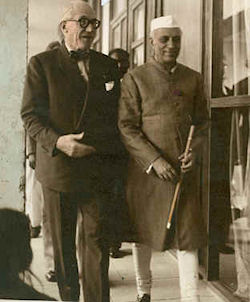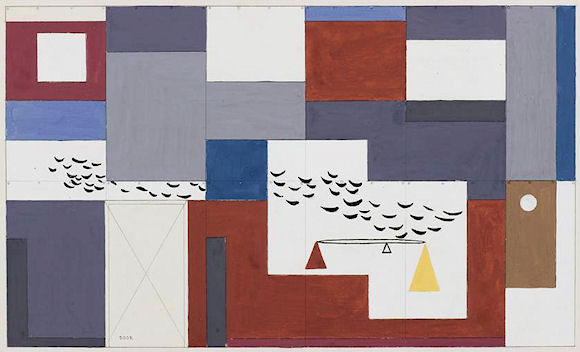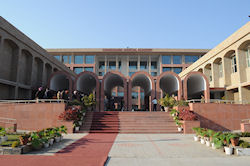Designed by Le Corbusier, a French Architect, the High Court has got a beautiful building. Apart from the Court rooms, it houses the Offices of many Administrative Branches such as Registrar's Office, Establishment Branch, Gazette Branch and Copying Branch etc. The Offices of Advocate-Generals, Punjab and Haryana also adjoin the main building.

An undated photograph of High Court of Punjab and Haryana and Le Corbusier.

Le Corbusier with Shri Nehru
Colourful tapestries, one to each courtroom, cover the entire rear wall -- 12 metres square in the main courtroom and 8 metres square for the smaller courtrooms. A number of symbols that encapsulated Le Corbusier's view of man, earth, nature, the emblems of India and the scales of justice were depicted in abstract, geometric patches. They were also required for acoustical reasons.

Design Sketch of Tapestry by Le Corbusier
These tapestry designs referred to the architectural plan, in particular Le Corbusier's exaltation of the right angle asbasic element of architecture, and of order generally. The designs are based on Le Corbusier's Modular, which he used to organise the entire Capitol Complex and give dimensions to all its buildings. He described the Modular as "a modest servant offered by mathematics to people desirous of harmony, a universal tool for all kinds of fabrications destined to be sent to all parts of the world. Furthermore, it solves by the decimal system the inextricable manipulation of the inch-foot system, an ancestral and totally respectable measure. The Modular is based on human height ... it places man at the centre of the drama, its solar plexus being the key to the three measures, which express the occupation of space by its members." The High Court was the first building to be made wholly of concrete. A sum of Rs 40 lacs was spent on its construction. The commendable success for the completion of the building by the target date was entirely due to the able administration of Sh P L Verma, Chief High Court building under construction Engineer and Secretary Capital Project and his assistantMr R C Singh, Executive Engineer. The construction of this unique building, which opened a new phase for concrete construction, was done by Messrs Hindustan Construction Corporation Ltd. Bombay under the supervision of Sh K C Iyya. It is one of the most beautiful High Courts in India with 40 spacious and luxuriously furnished courtrooms; 3 Bar rooms; a well-equipped Judges' library, a dispensary and a very good canteen. Its location in the lap of Himalayas beyond the limits of the city, beside Assembly Hall and Sukhna Lake adds to its beauty.
There is displayed a 'Balance', facing upward, outside Court Room No.1. This has been adopted as the Emblem of the High Court.This emblem was designed by Le-Corbusier. About this Emblem, Le-Corbusier said, "It is not the balance with two equal weights but one which is counter balanced in the complexities of the determinant factors: the length of the lever arms and the different weights which they support.

Emblem of High Court Punjab and Haryana

Judicial Academy located at Sector 43, Chandigarh
The High Court has also got a beautiful guest house situated at Chandigarh Judical Academy, Sector-43, Chandigarh, where visiting Judges of other High Courts can stay. Subject to the availability of accommodation, the guest house can also be used by the Judicial Officers, while on official duty.